Witch-hazel
Witch-hazels or witch hazels (Hamamelis) are a genus of flowering plants in the family Hamamelidaceae, with four species in North America (H. ovalis,[1] H. virginiana, and H. vernalis), and one each in Japan (H. japonica) and China (H. mollis). The North American species are occasionally called winterbloom.[2][3]
| Witch-hazel | |
|---|---|
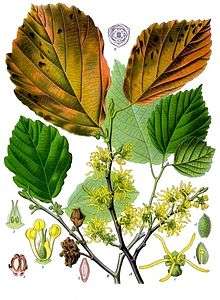 | |
| Hamamelis virginiana | |
| Scientific classification | |
| Kingdom: | Plantae |
| Clade: | Tracheophytes |
| Clade: | Angiosperms |
| Clade: | Eudicots |
| Order: | Saxifragales |
| Family: | Hamamelidaceae |
| Subfamily: | Hamamelidoideae |
| Tribe: | Hamamelideae |
| Genus: | Hamamelis Gronov. ex L. |
| Type species | |
| Hamamelis virginiana L. | |
Growth
The witch-hazels are deciduous shrubs or (rarely) small trees growing to 10–25 feet (3.0–7.6 m) tall, rarely to 40 ft (12 m) tall. The leaves are alternately arranged, oval, 2–6 in (5.1–15.2 cm) long and 1–4 in (2.5–10.2 cm) broad, with a smooth or wavy margin. The genus name, Hamamelis, means "together with fruit", referring to the simultaneous occurrence of flowers with the maturing fruit from the previous year.[4] H. virginiana blooms in September–November while the other species bloom from January–March. Each flower has four slender strap-shaped petals 3⁄8–3⁄4 inch (0.95–1.91 cm) long, pale to dark yellow, orange, or red. The fruit is a two-part capsule 3⁄8 inch (0.95 cm) long, containing a single 1⁄4 inch (0.64 cm) glossy black seed in each of the two parts; the capsule splits explosively at maturity in the autumn about 8 months after flowering, ejecting the seeds with sufficient force to fly for distances of up to 30 ft (9.1 m), thus another alternative name "Snapping Hazel".
Etymology
The name witch in witch-hazel has its origins in Middle English wiche, from the Old English wice, meaning "pliant" or "bendable", and is not related to the word witch meaning a practitioner of magic.[5] Jacob George Strutt's 1822 book, Sylva Britannica attests that "Wych Hazel" was used in England as a synonym for wych elm, Ulmus glabra;[6] The use of the twigs as divining rods, just as hazel twigs were used in England, may also have, by folk etymology, influenced the "witch" part of the name.[3]
Species
Five species are recognized:[7]
- Hamamelis japonica Siebold & Zucc.
- Hamamelis mollis Oliv.
- Hamamelis ovalis S.W.Leonard
- Hamamelis vernalis Sarg.
- Hamamelis virginiana L.
Hamamelis mexicana is sometimes considered a species,[8] though as of 2020 Kew's Plants of the World Online considers it a variety of H. virginiana.[7]
The Persian ironwood, a closely related tree formerly treated as Hamamelis persica, is now given a genus of its own, as Parrotia persica, as it differs in the flowers not having petals. Other closely allied genera are Parrotiopsis, Fothergilla, and Sycopsis (see under Hamamelidaceae). Witch-hazels are not closely related to the true Corylus hazels, though they have a few superficially similar characteristics which may cause one to believe that they are.
Cultivation
They are popular ornamental plants, grown for their clusters of rich yellow to orange-red flowers which begin to expand in the autumn as or slightly before the leaves fall, and continue throughout the winter.
Garden shrubs
Hamamelis virginiana was introduced into English gardens by Peter Collinson, who maintained correspondence with plant hunters in the American colonies. Nowadays, it is rarely seen in the nursery trade except for woodland/wildlife restoration projects and native plant enthusiasts. Much more common is H. mollis, which has bright yellow flowers that bloom in late winter instead of the yellow blossoms of H. virginiana which tend to be lost among the plant's fall foliage. The plant-hunter Charles Maries collected for Veitch Nurseries in the Chinese district of Jiujiang in 1879. It languished in nursery rows for years until it was noticed, propagated and put on the market in 1902.[9]
Numerous cultivars have been selected for use as garden shrubs, many of them derived from the hybrid H. × intermedia Rehder (H. japonica × H. mollis). Jelena and Robert de Belder of Arboretum Kalmthout, selecting for red cultivars, found three: the first, with bronze flowers, was named 'Jelena'; the next, with red flowers, was named 'Diane' (the name of their daughter); the last, with deep red flowers, was called 'Livia' (the name of their granddaughter).
Folk medicine
The leaves and bark of the North American witch-hazel, Hamamelis virginiana, may be used to produce an astringent decoction as a cooling agent for various uses in folk medicine, herbalism, and skincare products.[10] This decoction was widely believed to have medicinal uses by Native Americans.[3] The main constituents of witch-hazel extract include calcium oxalate, gallotannins, safrole, and chemicals found in the essential oil (carvacrol, eugenol).[11] Witch-hazel is mainly used externally on hemorrhoids, minor bleeding, and skin irritation.[10]
Witch-hazel is typically sold in pharmacies as witch-hazel water[3][10] and as semisolid ointments, creams, gels, and salves.[12] There is high-quality clinical evidence[13], as well as use in folk medicine, suggesting witch-hazel can ease discomfort involving vaginal soreness and hemorrhoids while they heal after childbirth.[14] It is commonly used to treat diaper rash in infants.[10] As an ingredient and as topical agent, witch-hazel water is regulated in the United States as an over-the-counter drug for external use only to soothe minor skin irritations.[15]
Extracts of witch-hazel may be used as a supposed remedy for psoriasis and eczema, in aftershave and ingrown nail applications, to prevent dehydration of skin, and for insect bites and poison ivy.[16] Clinical studies supporting its effectiveness for these skin conditions are absent.[10] There is no good clinical evidence for its other purported traditional uses, including gastrointestinal illnesses (diarrhea), common colds, tuberculosis, and inflammation.[10]
History
Native Americans used extract of witch-hazel extensively for medicinal purposes. Many people produced witch hazel extract by boiling the stems of the shrub and producing a decoction, which was used to treat swellings, inflammations, and tumors.[17] Early Puritan settlers in New England adopted this remedy from the natives, and its use became widely established in the United States.[16]
A missionary, Dr. Charles Hawes, learned of the preparation's therapeutic properties, and then determined through extensive study that the product of distillation (likely steam distillation) of the plant's twigs was even more efficacious.[17] "Hawes Extract" was first produced and sold in Essex, Connecticut, in 1846, by druggist and chemist Alvan Whittemore.[18]
Hawes' process was further refined by Thomas Newton Dickinson, Sr., who is credited with starting the commercial production of witch hazel extract, also in Essex, Connecticut, in 1866, and eventually establishing nine production sites in eastern Connecticut.[19] Following his death, his two sons, Thomas N. Dickinson, Jr., of Mystic, Connecticut, and Everett E. Dickinson of Essex, each inherited parts of the family business and continued the manufacture of witch hazel extract, operating competing "Dickinson's" businesses that were continued by their descendants.[16][20]
Safety
Although not fatal, oral consumption of witch hazel water is potentially toxic resulting from the high content of tannins remaining in commercial products.[10] As a result, the ingestion of witch hazel water is inadvisable during pregnancy and lactation.[21]
In the United States, witch hazel water can be used as an ingredient for topical applications,[15] but individual products are not approved as drugs. In 2017, one manufacturer of skincare products containing witch hazel was warned by the Food and Drug Administration for making unsubstantiated health claims and for not providing evidence the products are safe.[22]
Gallery
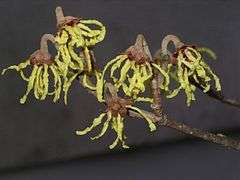 Hamamelis sp. flowers, Menai Bridge, Wales
Hamamelis sp. flowers, Menai Bridge, Wales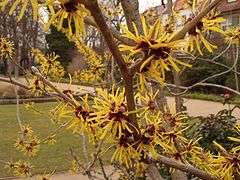 Hamamelis in Fürth City Park (Germany), 2004-02-08
Hamamelis in Fürth City Park (Germany), 2004-02-08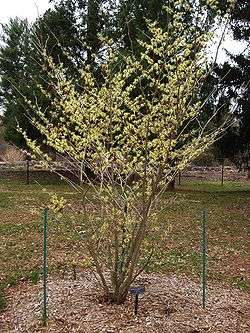 Hamamelis in the Colonial Park Arboretum and Gardens
Hamamelis in the Colonial Park Arboretum and Gardens- Hamamelis ×intermedia (H. japonica × H. mollis)
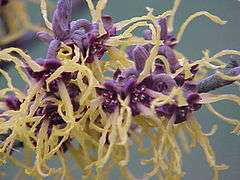 Hamamelis japonica
Hamamelis japonica
close-up flowers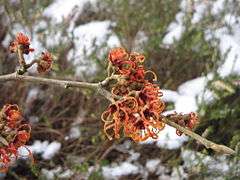 Hamamelis ×intermedia 'Jelena'
Hamamelis ×intermedia 'Jelena'- Hamamelis ×intermedia 'Diane'
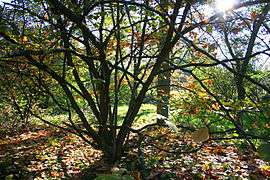 Hamamelis mollis tree in autumn
Hamamelis mollis tree in autumn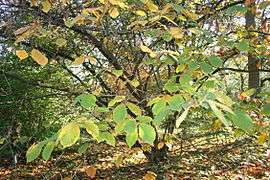 Hamamelis mollis in autumn
Hamamelis mollis in autumn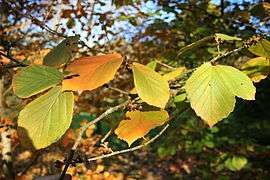 Hamamelis mollis leaves in autumn
Hamamelis mollis leaves in autumn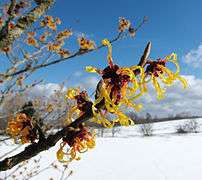 Winter-flowering in the Vogelsberg Mountains
Winter-flowering in the Vogelsberg Mountains Flourishing Witch-hazel shrub in winter
Flourishing Witch-hazel shrub in winter
References
- Hamamelis ovalis S. W. Leonard (2006), GRIN Taxonomy for Plants
- Noted in Ernest Thompson Seton, The Book of Woodcraft and Indian Lore (1921:422), but rare.
- Andriote, J-M (6 November 2012). "The Mysterious Past and Present of Witch Hazel". The Atlantic. Retrieved 13 April 2017.
- Hiker's Notebook: Witch Hazel
- Douglas Harper (2001). "witch hazel". Online Etymology Dictionary.
- Jacob George Strutt (1822). Sylva Britannica. p. 66. Full text of expanded 1830 edition.
- "Hamamelis Gronov. ex L." Plants of the World Online. Royal Botanic Gardens, Kew. Retrieved 13 August 2020.
- Xie, Lei; Yi, Ting-Shuang; Li, Rong; Li, De-Zhu; Wen, Jun (2010). "Evolution and biogeographic diversification of the witch-hazel genus (Hamamelis L., Hamamelidaceae) in the Northern Hemisphere". Molecular Phylogenetics and Evolution. 56 (2): 675–689. doi:10.1016/j.ympev.2010.02.018. PMID 20171295.
- Alice M. Coats, Garden Shrubs and Their Histories (1964) 1992, s.v. "Hamamelis".
- "Witch hazel". Drugs.com. 2009. Retrieved 13 April 2017.
- Sheila Boulajoun (2007). Natural Sources of Flavourings, Report No. 2. Belgium: Council of Europe Publishing. p. 87. ISBN 978-92-871-6156-7.
- "Witch hazel - topical". Health Canada: Drugs and Health Products. 13 April 2010. Retrieved 13 April 2017.
- "Anti-Inflammatory Efficacy of Topical Preparations with 10% Hamamelis Distillate in a UV Erythema Test". Skin Pharmacology and Physiology. doi:10.1159/000049400.
- "Postpartum care: What to expect after a vaginal delivery". Labor and delivery, postpartum care. Mayo Clinic. Retrieved 2013-01-01.
- "Code of Federal Regulations; Title 21, Sec. 347.52 Labeling of astringent drug products; (3) For products containing witch hazel". US Food and Drug Administration. 1 April 2016. Retrieved 14 April 2017.
- Michael C. Bingham, Which Witch Is Witch Hazel (and Which Dickinson Makes It)?, Connecticut Business Journal, 20 October 1997. Archived August 2, 2009, at the Wayback Machine
- Anthony C. Dweck, Ethnobotanical Use of Plants, Part 4: The American Continent.
- Dickinson's 'Witch Hazel' Will No Longer Be Manufactured in Essex, Essex Events, Spring 1997.
- The E.E. Dickinson Co. (1970?), The Birth of Witch Hazel. 16 pp.
- About Dickinson Brands, Dickinson Brands website, accessed February 4, 2010.
- Burlando, B; Verotta, L; Cornara, L; Bottini-Massa, E (2010). Herbal Principles in Cosmetics: properties and mechanisms of action. Boca Raton, Florida: CRC Press. p. 365. ISBN 978-1-4398-1214-3.
- Bromley, Gerald D. (6 March 2017). "Warning letter: Aegeia Skin Care, LLC". Inspections, Compliance, Enforcement, and Criminal Investigations, US Food and Drug Administration. Retrieved 13 April 2017.
Further reading
- Erdelmeier, C. A. J. et al. Antiviral and Antiphlogistic Activities of Hamamelis virginiana Bark. Planta Medica, 62(1996) (3):241–245
- Foster, S. The Wiley Witch Hazel. The Herb Companion.(January 1989).
- Fergus, Charles (2002). Trees of Pennsylvania and the Northeast. Stackpole Books. pp. 156–9. ISBN 978-0-8117-2092-2.
- Huxley, A., ed. (1992). New RHS Dictionary of Gardening. Macmillan.
- Korting, H. C., et al. "Comparative Efficacy of Hamamelis Distillate and Hydrocortisone. European Journal of Clinical Pharmacology 48(1995)(6):461–465.
- Lloyd, J. U. and J. T. Lloyd. History of Hamamelis (Witch Hazel), Extract and Distillate. Journal of the American Pharmaceutical Association. 24(1935) (3):220–24.
- Tyler, V. E. Herbs of Choice: The Therapeutic Use of Phytomedicinals, Binghamton, New York: Pharmaceutical Products Press, 1994.